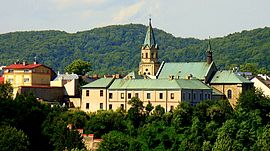Franciscan monastery (Sanok)

The Franciscan Monastery of Sanok is a Roman Catholic male monastery founded by the Friars Minor of St. Francis of Assisi in the first half of the 14th century on the bank of the San in the center of the Polish city of Sanok . The fragment of the wall of this monastery is from the 14th century and its interior from the 17th century. On the main altar you can see a great crucifixion from the 18th century and on the left side altar a picture of Our Lady of the Earth by Sanok from the 16th century.
It was the first religious settlement in the city of Sanok, right next to the monastery building on the southeast corner of the market square is the Franciscan church, whose history begins in the 14th century. Franciszkańska Street and the historic Franciscan staircase from the Blonia plain on the Plowce Brook, which serve as connections to the suburbs, open into the courtyard of the monastery through the gate.
The Franciscan Church of Sanok adjoins the convent building, today's parish church of the Sanok Cross. The monastery church with the distinctive tower is the parish church of the parish Sanok - Exaltation of the Cross in the Deanery Sanok and belongs to the town church Sanok.
This building is financially supported by the Foundation for German-Polish Cooperation with funds from the Federal Republic of Germany .
history
The first Minor Brothers of St. Francis of Assisi arrived in Przemyśl around 1237 . In 1377, at the request of the Przemysl Bishop Erich von Winsen , governor Ladislaus von Opole founded a Franciscan hospice with a pilgrimage church (later a monastery) in honor of "the Virgin Mary" in the suburbs behind the walls of the city of Sanok .
The new church in honor of the discovery of the Holy Cross , a foundation from Queen Elisabeth , was built by Starost in the years 1384-1387. The monastery church was located in the old town on the south-eastern edge of the Sanok city walls, where it still stands today. At the south-east corner of the monastery church is the neo-Gothic "Old Town Hall" from the end of the 18th century with a tower clock in the entrance and the city coat of arms. To the northeast opposite are the old houses of the city.
In the late Middle Ages many Christian associations arose here, especially the Brotherhood of Passion , the Brotherhood of the Belt of St. Francis of Assisi , Brotherhood in Honor of St. Ivo , Brotherhood of St. Anna , Brotherhood of the Scapular of the Blessed Virgin Mary and Belt Brotherhood of Our Lady .
In 1855 some of the monastery rooms served as a detention and district court in Sanok.
In the 17th century the monastery was taken over by the Franciscan Observants (OFM), who have owned it ever since. It was funded in 1606 on the initiative of the landowner Petrus Bal. After a fire in 1637, the church was rebuilt in Baroque style without a tower.
The tower, which burned down in 1743 and fell victim to the flames again in 1872, was renewed in the neo-Romanesque style in 1895 according to a project by the Galician architect Władysław Beksiński.
Karner
Under the Francis altar there is a tomb with the bones of noble families.
Web links
Individual evidence
- ↑ “This would indicate that the Franciscans in Przemysl had a settlement before 1377, which would have been expanded by Bishop Erich. A little later the convent at Sanok came into being. ”In: Franciscan Studies. 1929 p. 109
- ↑ "Sanok spreads out on a hill on the upper San River, with its old Franciscan monastery." In: Galizien: Land und Menschen. P. 157
Coordinates: 49 ° 33 ′ 37 ″ N , 22 ° 12 ′ 25 ″ E
